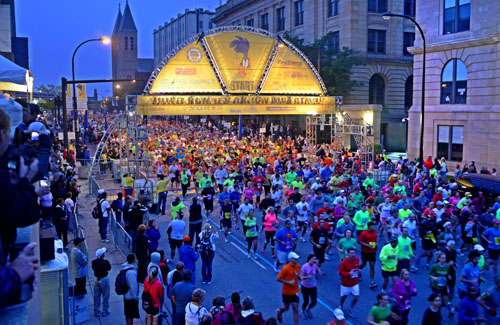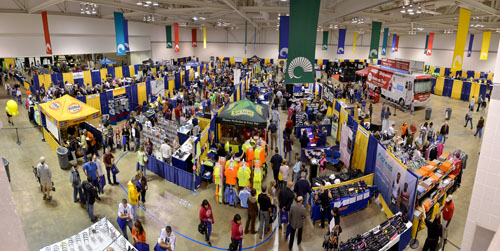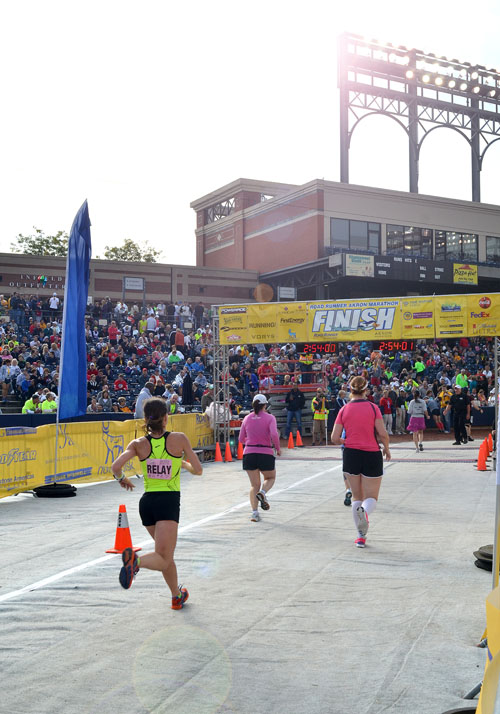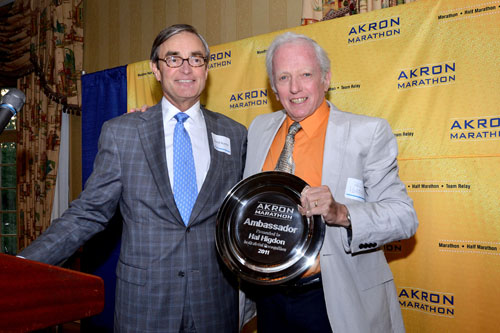Dave Hunter is a lawyer/running enthusiast from Akron, Ohio. We asked Dave to develop a four piece series on how the Akron Marathon developed, from beginning dreams to AkRUN it is today. This is the first of four sections, we hope that you enjoy it.
I remember going to the first Akron Marathon, it was pretty amazing to listen to the excitement from the locals and their dreams of making the marathon grow and feature the city of Akron.
There are lessons in this story for the cities and towns considering a race, and for the established races. Whether it be the late Fred Lebow, trying to get the first sponsor for the five boroughs version of the New York City Marathon in 1976, or Steve Marks, telling David of his dream for the Akron Marathon, the stories are both filled with dreams, frustration, dreams, frustration, frustration, dreams. This is how the Akron Marathon team made their dreams a reality.
For our sport to develop, it is key that we learn from each other. Mr. Hunter’s piece shows us the hard work that is involved when one goes from dream to reality…we hope you enjoy the piece as much as we have enjoyed the assignment, and remember, come back the next three Mondays for the upcoming sections!
 AkRUN, Starting Line 2011, courtesy of AkRun
AkRUN, Starting Line 2011, courtesy of AkRun
From Akron to AkRUN: One Marathon’s Journey
(Part 1 of a 4 Part Series):
The Vision
It was a typically raw, late winter day in March 2002 as I slid out of the wind and into the Grille Room of a suburban country club near Akron, Ohio. I was a few minutes late for a luncheon meeting with Steve Marks, a resourceful and successful entrepreneur who wanted to share with me his vision to create a marathon in Akron. This would be my first meeting with Steve, a man whose reputation as a bright and innovative business man preceded him. Over lunch, I smiled broadly as Steve outlined his thoughtful and comprehensive grand vision of 10,000 runners competing in the streets of Akron. I was able to restrain some of my initial skepticism as I reminded myself that this is the man who started his business by purchasing an abandoned building in downtown Akron with a newly-issued credit card and ultimately transformed a muffin store into a publicly-traded enterprise that has become one of the most highly-respected and successful manufacturers of frozen gourmet bakery goods in the country.
During our lunch, my restrained skepticism turned first to interest and then to guarded enthusiasm as I realized Steve had already laid an important foundation for this marathon vision through earlier pivotal meetings with key community leaders. More importantly, he was wise enough to allow an additional glide path of over 18 months until the initial race day of October 11, 2003. During my long runs over the years, I would often daydream about just this type of vision: a marathon for Akron. But when my endorphin-induced fantasy would subside and the realities of my real world obligations with my family and private law practice, etc. returned, I would routinely dismiss my flight of fancy as an intriguing idea for another time. But lunch with Steve changed all that. He had performed a lot of the spade work; he had the financing; and he allowed himself adequate additional time to assemble the many remaining organizational pieces. “This could be done”, I thought as we shook hands after lunch. I was in… and I was hooked.
The next step was completing the assembly of our leadership team. Steve had already secured the commitment of another local businessman, Jim Barnett, to serve as race director. Jim – a former Marine, a rugged outdoorsman, and an avid skier – lives 10 miles north of Akron on the banks of the Cuyahoga River in the expansive and beautiful Cuyahoga Valley National Park. With his boundless enthusiasm and energy, Jim would be the perfect symbol for our race. Steve looked to me to bring additional running experience and expertise into our leadership group. I tapped two of my running buddies: Bret Treier, a 3:06 marathoner and a top-flight corporate lawyer, who would work with me to create and manage the race course; and Don Luscher, a 2:32 marathoner and a hyper-organized healthcare executive, who would manage the starting line. The assembly of the rest of the leadership team followed a basic credo: the identification and selection of passionate individuals who share and possess the common bond of running with proven organizational skills.
 Expo Panorama, 2011 AkRUN, photo courtesy of AkRun
Expo Panorama, 2011 AkRUN, photo courtesy of AkRunThe next step – an essential one – was forging a collaborative relationship with the City of Akron. (Cities like Pittsburgh know all too well – both the good and the bad – how essential municipal support is in putting on a city-wide marathon.) Akron Mayor Don Plusquellic, himself a visionary, immediately appreciated the upside potential of a city-wide marathon and knew the significant positive economic impact that such an event, if successful, would have on the region. The city’s assistance was complete: from safety surveillance at intersections to bicycle fencing for crowd control – and everything in between. The city even agreed to paint a blue line of 26 miles 385 yards to mark our course.
Another key ingredient proved to be the city itself. The people of Akron and the culture of the city reflect a long heritage of a can-do attitude and hands-on involvement. Akronites never disappoint. Within days after the September 11 attacks, Akron residents, almost by magic, assembled the funds, purchased a state-of-the-art fire truck, and drove it to lower Manhattan to present it to the New York Fire Department as a gift from the City of Akron. Committed attention to detail has allowed Akron to serve as the site of the All-American Soap Box Derby since 1934 and allowed Akron’s Firestone Country Club to host PGA tournaments – including the World Series of Golf, three PGA Championships, and, currently, the Bridgestone Invitational – every year since the mid-1950s. We knew if we could capture the City’s proven imagination the rest would take care of itself.
Great care was taken to design a top flight marathon course. Our focus? To assemble a course which would allow our marathoners to see all of our town. Essentially a tour of greater Akron on foot, the Akron Marathon race course now features a dramatic dawn start over the All American Y Bridge (think NYC Marathon start over the Verrazano-Narrows Bridge), a tour through the town’s rebounding inner city, a visit to several venerable residential neighborhoods, a four-mile stretch along the Cuyahoga River on the crushed limestone Towpath Trail, a three-mile run through the tree-canopied grandeur of Sand Run Metro Park, a half-mile loop through Stan Hywet Hall and Gardens (the gated grounds and mansion which decades ago served as the home of F.A. Seiberling, founder of the Goodyear Tire & Rubber Company), and an ultrafast final two-mile descent back downtown for an exciting Olympic-style finish inside Canal Park – the town’s 9,100-seat HOK ballpark and home of the Akron Aeros, the Cleveland Indians AA farm team.
 2011 AkRUN finish in stadium, courtesy of AkRUN
2011 AkRUN finish in stadium, courtesy of AkRUN All of this preparation led us to our final examination: our first race day. The meteorological gods shined upon us as race day emerged as a beautiful, crystal clear, bracing fall day. With the beloved Goodyear blimp hovering overhead, the emotions of our 3,500+ runners peaked as the national anthem was sung and the race began. Notwithstanding a brief on-course train crossing – which caused a momentary delay to only three of our speedier relayers (You didn’t expect us to pitch a perf
ect game in Year One, did you?) – the race was a boisterous and joyful success. On into the early afternoon, marathoners and team relayers continued to stream through the center field fence toward the Canal Park finish line and were greeted with a hearty hand shake from our race director – a personal finish line congratulation he still provides to every finisher every year. We surveyed the broad array of human emotions displayed by our finishers: the strong, determined finish of an experienced veteran; the unbounded joy of an exhilarated first-time marathoner; the quiet display of tearful emotion of a marathoner running in memory of a departed loved one. There could be no doubt: we knew we had struck a resonating chord in our city. We were on our way.
written by Dave Hunter
 Dave Hunter (the writer) and Hal Higdon (Famous Running Columnist, Writer, Masters record holder), photo courtesy of AkRUN
Dave Hunter (the writer) and Hal Higdon (Famous Running Columnist, Writer, Masters record holder), photo courtesy of AkRUN
Next week: Street Cred
Author

Larry Eder has had a 52-year involvement in the sport of athletics. Larry has experienced the sport as an athlete, coach, magazine publisher, and now, journalist and blogger. His first article, on Don Bowden, America's first sub-4 minute miler, was published in RW in 1983. Larry has published several magazines on athletics, from American Athletics to the U.S. version of Spikes magazine. He currently manages the content and marketing development of the RunningNetwork, The Shoe Addicts, and RunBlogRun. Of RunBlogRun, his daily pilgrimage with the sport, Larry says: "I have to admit, I love traveling to far away meets, writing about the sport I love, and the athletes I respect, for my readers at runblogrun.com, the most of anything I have ever done, except, maybe running itself." Also does some updates for BBC Sports at key events, which he truly enjoys. Theme song: Greg Allman, " I'm no Angel."
View all posts




















